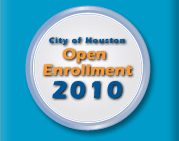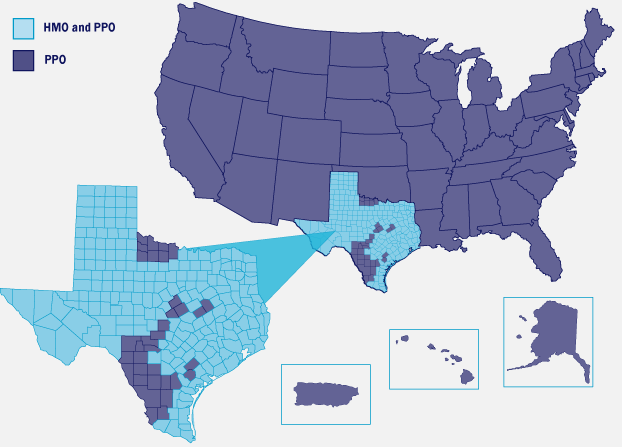|
| Enrollment Materials Checklist |
- Open enrollment guide
- Comparison chart
- Employee or retiree medical/dental forms
- SMART! guide
|
Health Plan Highlights
Health plan preview
| Who's in the game? |
| Who |
HMO |
PPO |
Total |
Employees
|
21,366 |
496 |
21,862
|
| Retirees |
6,817 |
368 |
7,185 |
| Dependents |
36,654 |
385 |
37,039 |
| MA enrollees |
|
|
2,834 |
| Total |
64,837 |
1,249 |
68,920 |
| Data Date: 12/31/2009 |
Here’s your health plan scouting report — you have two options for your comprehensive medical plans, HMO and PPO. Both deliver championship care with predictable, budget-friendly costs.
The HMO plan requires that all your care be directed by your primary care physician. You must use network providers, except in case of emergency or referral by your network doctor.
The PPO plan offers more flexibility, more doctors, no PCP requirement and the option to go out-of-network. But you pay more for the added flexibility, in your contribution and at the time of service.
Type of services
Copayments for primary-care services and specialist services are determined by the type of service.
- If the service is performed by the PCP in the office, the lower copayment will apply, $25 in the HMO and $35 in the PPO in-network.
- If the service is performed in a specialist’s office, or in another location, the higher specialist copayment will apply, $50 in the HMO and $55 in the PPO in-network.
- Most services such as home visits, family planning, infertility treatment, physical therapy, and similar services are “specialist services,” and you will pay the higher copayment. Note: artificial insemination requires a 50 percent copayment of usual and customary for each procedure.
To see a comparison of plan features and your out-of-pocket costs, click here.
What’s new
Because of the rising cost of health care, we’ve had to adjust the copayment structure for doctors’ visits and prescription drugs. And for the first time, you can opt out of your city health plan at retirement and come back at a later date.
1. Copayments are changing
In an attempt to lessen the amount of your biweekly contribution increase, we’re increasing your copayments slightly. As of May 1, HMO members will pay $25 when you visit your primary-care physician, and $50 when you visit a specialist. PPO members will pay $35 when visiting your primary-care physician, and $55 when you visit a specialist.
Copayments for preferred brand-name drugs and non-preferred brand-name drugs are increasing $5 for a 30-day supply and $10 for a 90-day mail-order supply. Generics will remain $10, or less for many drugs at many stores.
| Changes in office visit copayments |
| |
From |
To |
| HMO PCP visit |
$20 |
$25 |
| HMO specialist visit |
$45 |
$50 |
| PPO PCP visit |
$30 |
$35 |
| PPO specialist visit |
$50 |
$55 |
| Changes in prescription copayments |
| |
From |
To |
Preferred brand name
30-day supply |
$30 |
$35 |
Non-preferred brand name
30-day supply |
$45 |
$50 |
Preferred brand name
90-day supply mail-order |
$60 |
$70 |
Non-preferred brand name
90-day supply mail-order |
$90 |
$100 |
2. Retirees can opt out of their city insurance plan and return to the city insurance plan in the future
Retirees will be able to disenroll from their city plan and re-enroll later. This Opt-out Opt-in feature could save you money during the opt-out period while providing you the security of knowing you can re-enroll in a city plan again in the future.
New Opt-out Opt-in feature for retiring employees and retirees
As a retiree, you have come to expect city medical and dental benefits. In the past, if you waived these benefits, you couldn’t come back to your city plan. Your only option was to keep the city’s plan, even if you could get less-costly coverage somewhere else.
Now, you can opt out of your city benefits and re-enroll later. So when you and your spouse are no longer eligible for medical benefits from another source you can still get great city benefits coverage. Even if you have a city Medicare plan, you can opt out and return later.
For retirees, there are rules that Medicare plans must follow. So before you opt out, check with your plan administrator about how Medicare’s rules will affect you. If you opt out of your city Medicare plan, you’ll automatically be enrolled in Original Medicare, and you’ll have to enroll in a prescription-drug plan if you want prescription-drug coverage. If you do not have a creditable Medicare Part D prescription-drug plan during your opt-out period, you may be limited to when you can enroll in a Part D plan and you may have to pay late-enrollment penalties.
Your opt-out applies to your dependents, including dependents covered under a Medicare plan. So if you drop your city coverage, your dependents’ city coverage will be dropped as well.
You can opt back into a city plan during any open enrollment, after a family status change that causes you to lose coverage, or after a 90-day waiting period.
To opt out, you must submit a Retiree Medical/Dental Opt-Out form to HR benefits. Your opt-out election is effective the first of the month after HR benefits receives your form. For more information, call 713-837-9400.
To re-enroll, you’ll need to submit a Retiree Medical/Dental Opt-In form to HR benefits and provide relationship documents for dependents you want to cover. If your opt-in election is caused by loss of coverage, you’ll need to submit a Certificate of Coverage from the insurance company or the company that provided the medical plan. You must opt in within 31 days after the family status change, or you’ll have to wait through the 90-day eligibility period.
Health plan features at-a-glance |
Plan feature |
What you pay |
| |
HMO |
PPO
in-network |
PPO
Out-of-network |
Deductible (Individual/Family) |
N/A |
$200 / $600 |
$400 / $1,200 |
PCP office visit copayment |
$25 |
$35 |
40% |
Specialist office visit copayment |
$50 |
$55 |
40% |
Routine physical copayment |
$0 |
$0 |
40% |
Well woman/man exam |
$0 |
$0 |
40% |
Inpatient admission copayment/coinsurance |
$500 |
$500 + 20% |
$1000 + 40% |
Emergency room |
$150 |
$150 + 20% |
$150 + 20% |
Ambulance |
$100 |
20% |
20% |
Outpatient surgery |
$200 |
20% |
40% |
Annual maximum copayment/coinsurance |
Individual |
$1,500 |
$3,000 |
$5,000 |
Family |
$3,000 |
$6,000 |
$10,000 |
Prescriptions participating pharmacy copayment* |
Retail pharmacy
(30-day supply) |
Generic |
$10 |
$10 |
$10 |
Preferred brand |
$35 |
$35 |
$35 |
Non-preferred brand |
$50 |
$50 |
$50 |
Mail-order pharmacy
(90-day supply) |
Generic |
$20 |
$20 |
$20 |
Preferred brand |
$70 |
$70 |
$70 |
Non-preferred brand |
$100 |
$100 |
$100 |
*Generics are mandatory if available.
| Doctors in the HMO and PPO |
Physician group |
HMO |
PPO |
Baylor |
|
X |
CardioVascular Care Providers, Inc. |
X*** |
X |
Independent Physicians, if listed |
X |
|
Inpatient Consultants of Texas |
|
X |
Kelsey-Seybold Clinics |
X |
X |
MD Anderson Cancer Center |
X*** |
X |
Medical Clinic of Houston |
|
X |
Memorial Hermann Healthnet Network Providers |
X** |
X |
Northwest Diagnostic Clinic |
X |
X |
OB/Gyn Associates |
|
X |
HMOBlue TX Limited Provider Network |
X |
X** |
Renaissance |
X |
X** |
Sadler Clinic |
X |
X |
| Texas Children's Physician Group |
X* |
X |
UT Physicians |
|
X |
UTMB-Galveston |
|
X |
* Pediatricians/specialty care providers participating in the HMO network.
** Physicians may be available through independent contracts instead of through the IPA.
***Available through referral only.
****Kelsey-Seybold no longer provides services to Medicare-covered PPO members. See page 10 for more information.
Service Areas
| Enrollment Options |
| If you are currently enrolled in: |
You may enroll in one of these plans during this enrollment: |
| HMO |
PPO |
OOA** |
| HMO |
-
|
yes
|
no
|
| PPO |
yes* |
- |
no |
| OOA |
yes* |
yes* |
- |
*If you live in the plan’s service area.
**The out-of-area plan is only available to employees/retirees who live outside the PPO/HMO service area. |
The map below shows the broad coverage of the service area for HMO and PPO plans. The HMO includes more than 200 counties in Texas and the PPO includes every state, plus Puerto Rico. Your ID card is accepted by additional doctors and hospitals and a larger retail pharmacy network.
HMO
The HMO service area is as big as the state of Texas, except for these 34 counties — Archer, Bandera, Baylor, Clay, Coryell, DeWitt, Dimmit, Duval, Edwards, Falls, Foard, Frio, Gillespie, Goliad, Hamilton, Hardeman, Jim Hogg, Kerr, Kinney, Knox, LaSalle, Lampasas, Limestone, Live Oak, Llano, McMullen, Maverick, Real, Uvalde, Webb, Wichita, Wilbarger, Zapata, Zavala.
PPO
The BlueChoice PPO network is as big as America itself. That means employees and retirees under the plan can find contracted providers in every state, plus Puerto Rico.
To help you decide which plan is right for you, the chart below gives you a comparison of plan details.
| Which plan is right for me? |
| Feature |
HMO |
PPO |
| Concept |
You must select a PCP. Services are available from specific doctors for a specific copayment: no claims to file: no coverage out-of-network (except for emergencies and referrals). |
Services are available from a large network of doctors; services are subject to deductible, copayment and coinsurance; you may have to file a claim; out-of network coverage is available at a lower benefit rate. |
| Network |
1,397 PCPs, 4,517 specialists and 2,525 hospital-based physicians in 19 counties around the Houston-Galveston area. Network doctors throughout Texas. |
2,615 PCPs, 6,171 specialists and 3,052 hospital based physicians in 19 counties around the Houston-Galveston area. More than 720,000 doctors across the U.S. |
| Service area |
220 counties in Texas. |
All 50 states, plus Puerto Rico. |
| Network services |
Except for emergency care and approved referrals, only services provided in the network are covered. |
Services performed in-network and out-of-network are covered at different levels. |
| Primary Care Physician |
Your PCP coordinates all medical care. |
Freedom to chose any doctor, hospital, or specialist. |
| Referrals |
PCP must refer you to specialists. |
Referrals are not required. |
| Deductible |
No deductible or coinsurance. |
$200/$600 in-network.
$400/$1,200 out-of-network. |
| PCP visit |
Most common copayment is $25. |
Most common copayment is $35 in-network. |
| Specialist visit |
Most common copayment is $50. |
Most common copayment is $55 in-network.. |
| Coinsurance |
Most services covered at 100% after copayment. |
Services covered 80% (or 60% out-of-network) after annual deductible. |
| Billing |
No balance billing.
No claims to file. |
No balance billing, unless you seek out-of-network services; you must file a claim to seek reimbursement. |
| Preventive Care |
Routine preventive care such as well-baby, well-woman and well-man exams are free: annual physicals are covered with $0 copayment. |
Preventive care such as well-woman and well-man exams are free in-network and annual physicals are covered with $0 copayment. Limitations for out-of-network. |
|
|


